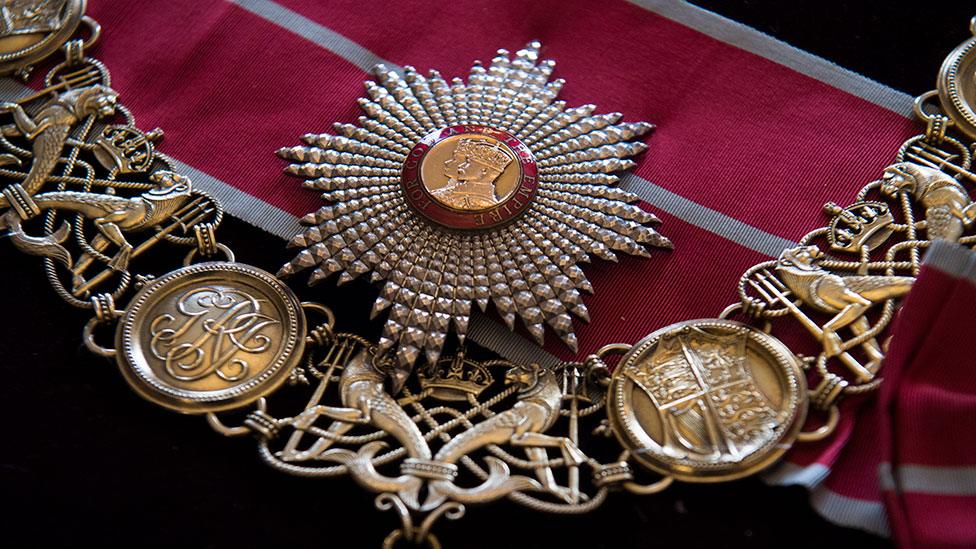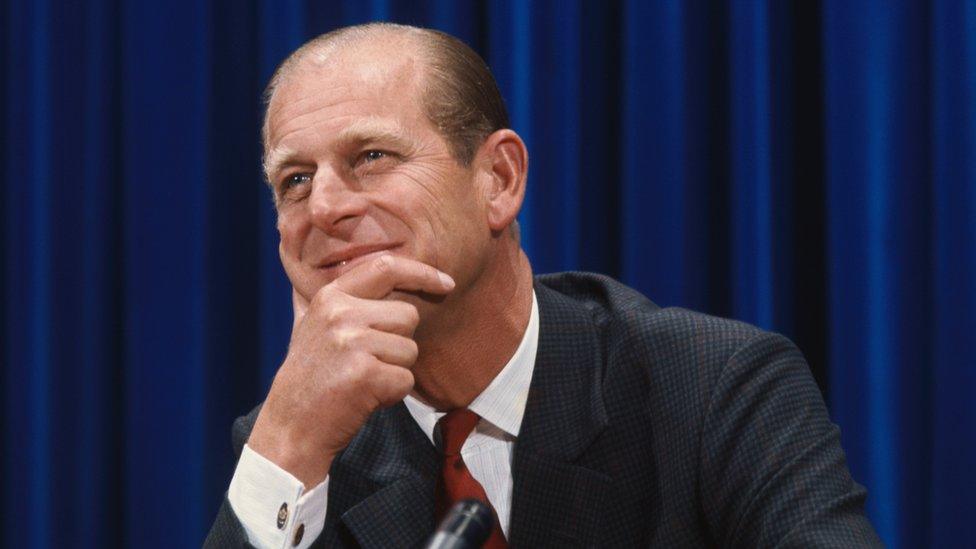Prince Philip funeral: Plans, timings and TV coverage
- Published

Funeral preparations are under way for Prince Philip, Queen Elizabeth II's husband, who died on Friday 9 April aged 99.
This is what we know about the event.
Where will the funeral take place?
The ceremonial royal funeral will be held at St George's Chapel, in the grounds of Windsor Castle, at 15:00 BST on Saturday 17 April.


Prince Philip's body is now resting in the inner hall at Windsor Castle after being moved from its private chapel.
The duke is reported to have requested a funeral of minimal fuss and has not lain in state - where members of the public would have been able to view his coffin.
The procession and service will be televised - details below.
Who will attend the funeral?
Coronavirus restrictions in England mean only 30 people, socially distanced, are allowed to attend funerals.
The guest list includes members of the Queen and Duke of Edinburgh's families, including three of his German relatives.
Prince Harry will attend but his wife Meghan, who is pregnant, will not make the trip from the US, on medical advice. It is the first time the Duke of Sussex has returned to the UK since stepping down as a senior royal last year.
Attendees are expected to wear masks in line with government advice. The pallbearers and clergy are not included in the number of attendees.
What will happen on the day?
The duke will have a ceremonial funeral, rather than a state funeral. There is a subtle difference - state funerals are usually reserved for monarchs, although wartime Prime Minister Winston Churchill was given a state funeral. The Queen Mother had a ceremonial funeral in 2002, as did Diana, Princess of Wales in 1997.
On the day of the funeral, the coffin will be moved from the private chapel to the State Entrance of Windsor Castle. It will be placed on a modified Land Rover, that the duke himself helped design, to be carried the short distance to St George's Chapel.




Coronavirus restrictions on crowds and numbers attending funerals mean the duke's ceremonial funeral will be much lower key than if it had happened in other times - although the Palace says this very much "reflects the duke's wishes" and it will still "celebrate and reflect" a life of service.
Can I watch the funeral on TV?
Live online coverage of the procession and funeral begins on the BBC News website and app at 07:00 BST and the service will be streamed in the UK and internationally.
Television coverage in the UK starts at 12:30 BST on Saturday on BBC One, the BBC News Channel and on BBC iPlayer.
On the radio, you can follow the day's events between 14:00 BST and 16:10 BST on Radio 4 and Radio 5 Live, and simulcast on BBC World Service English, BBC Radio Scotland, and BBC Radio Ulster.
BBC Radio Wales and BBC local radio will also cover the event, with start times to be confirmed.
What time is the funeral?
By 14:15 BST, the Quadrangle in Windsor Castle will be lined by the Household Cavalry and the Foot Guards, along with military detachments from units that had special connections with Prince Philip on the grass.

From 14:20 BST, those members of the Royal Family and The Duke of Edinburgh's family not taking part in the procession leave Windsor Castle by car for St George's Chapel.

At 14:40 BST, the bands in the Quadrangle stop playing and the coffin will be carried out and placed onto the Land Rover.
Members of the Royal Family walking in the procession will leave the State Entrance after the coffin and take up their positions.
Behind the Land Rover will be Princes Charles, Andrew, Edward and Princess Anne, as well as grandsons Princes William and Harry. They are joined by Princess Anne's son Peter Phillips, her husband Vice Admiral Sir Tim Laurence and the Earl of Snowdon. Members of the duke's staff will follow behind them, including his private secretary Brigadier Archie Miller Bakewell, a personal protection officer, two pages and two valets.

At 14:45 BST, the procession begins. Led by the band of the Grenadier Guards, the procession will move from the Quadrangle to Horseshoe Cloister. The band is followed by the Major General's party and military chiefs of staff. The Land Rover follows, flanked by pallbearers from the Royal Marines and other regiments and corps associated with the duke. The Royal Family members and staff follow behind.
The Queen will travel at the rear of the procession in the State Bentley and will enter St George's chapel through the Galilee porch.
The procession route will be lined by personnel from the Royal Navy, Royal Marines, The Highlanders, 4th Battalion Royal Regiment of Scotland and the Royal Air Force.
Guns will be fired by The King's Troop Royal Horse Artillery from the East Lawn throughout, as a bell tolls in the Curfew Tower, at the west end of the castle.

At 14:53 BST, the Land Rover will arrive at West Steps of St George's Chapel, and be met by a guard of honour and band from the Rifles Regiment, who will play the national anthem.
Members of the Household Cavalry will line the West Steps and a Royal Navy "piping party" will pipe a nautical call known as "the Still" as the coffin is carried up the steps to the chapel.
The coffin, draped with the duke's standard, with a wreath and the duke's naval cap and sword on top, will be met by the dean of Windsor, together with the Archbishop of Canterbury, for the service.
Only the members of the Royal Family will enter the chapel - the rest of the procession will remain outside.

At 15:00 BST, a minute's silence will be held nationwide, in memory of the duke.
The start and end of the Silence will be signalled by a gun fired by The King's Troop Royal Horse Artillery.
Inside the chapel, the funeral service will begin as the coffin is carried to the Quire, and placed on a platform called a catafalque.
A small choir of four singers, who will be in the nave of the chapel, will sing pieces of music chosen by the duke.

After the service, the duke will be interred in the royal vault.
Flag and insignia
The duke's coffin is draped in his personal flag, his standard. The flag represents elements of his life, from his Greek heritage to his British titles.
When the duke got engaged to the then Princess Elizabeth in 1946, he renounced his Greek title and became a British citizen, taking his mother's anglicised name, Mountbatten.
The Mountbatten family is therefore also represented on the standard, alongside the castle from the arms of the City of Edinburgh - he became Duke of Edinburgh when he married.


A number of objects personally selected by the duke will be displayed on cushions on the altar in St George's Chapel.

The British Empire Breast Star and Badge and the British Empire Collar will be on display
These include the duke's insignia - medals and decorations awarded to him by the UK and Commonwealth countries - his field marshal's baton, Royal Air Force wings and insignia from Denmark and Greece


How can the public pay their respects?
Members of the public have been asked not to attend any of the funeral events, in line with public health advice.
On the Royal Family website, external, members of the public are asked to consider making a donation to a charity instead of leaving floral tributes in memory of the duke. An online book of condolence, external is also available for the public to post their personal tributes.
What happens after the funeral?
The period of national mourning ends on the day of the funeral.
The Royal Family will continue to observe mourning for another week - but members will attend engagements wearing black mourning bands where appropriate.


- Published9 April 2021

- Published9 April 2021
